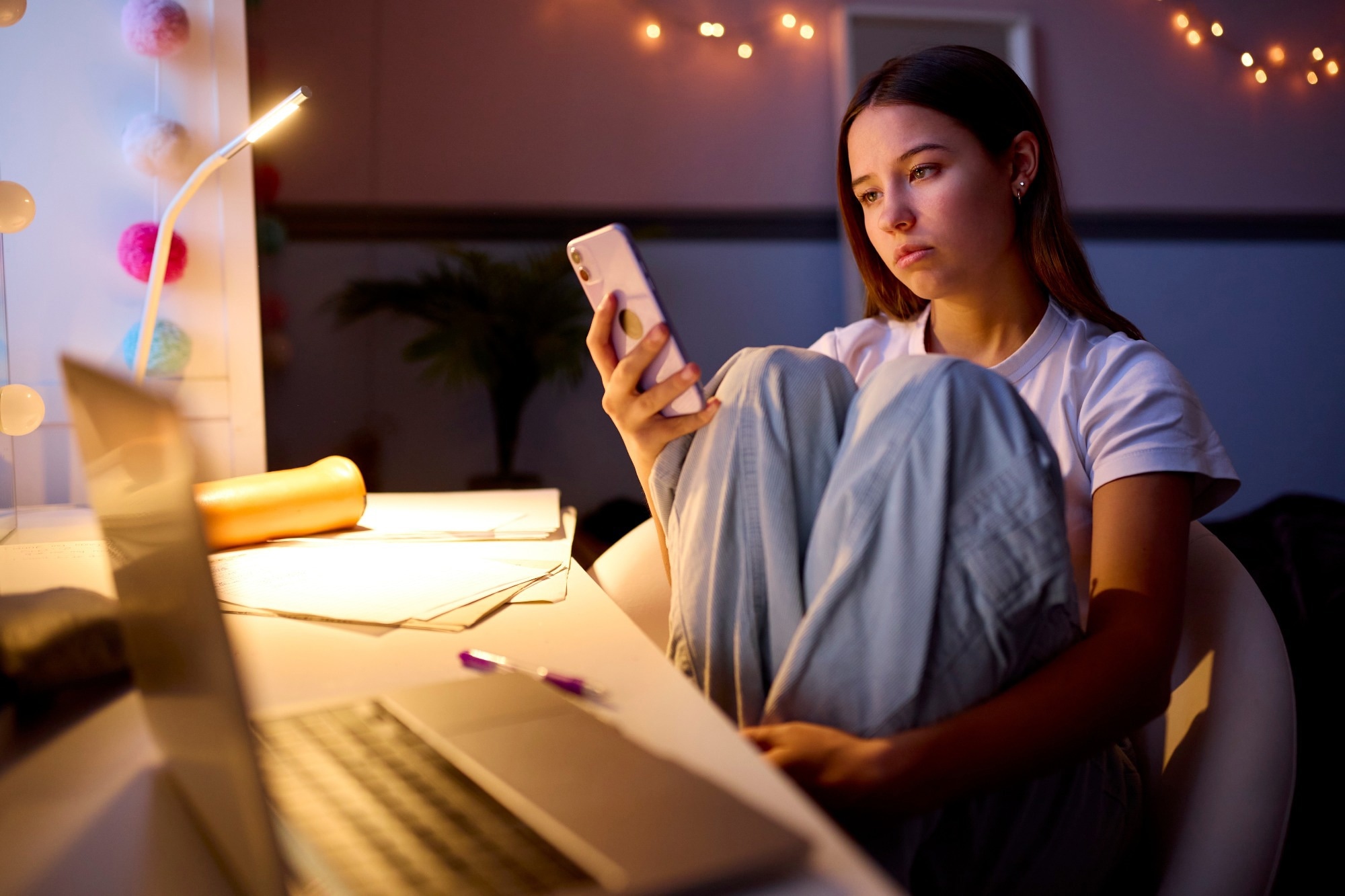In a recent article published in BMC Public Health, a group of researchers presented detailed insights from 33 adults in Aotearoa (New Zealand) who are parenting adolescents.
The primary objective of the study was to gain a comprehensive understanding of parental perspectives on the regulation of adolescent screen time.
The study titled ‘I tried to take my phone off my daughter, and I got hit in the face’: a qualitative study of parents’ challenges with adolescents’ screen use and a toolbox of their tips was conducted.
Background
Adolescents today are immersed in a digital world that often leads to addictive behaviors, with constant screen usage observed throughout the day and night.
Research indicates that teenagers spend up to 11 hours daily on various screen-based devices like smartphones, tablets, computers, and televisions. However, most existing research in this area is quantitative and primarily focuses on younger children rather than adolescents.
It is crucial for parents to have a say in how their teenagers use screens. Parents not only provide these devices and set guidelines for their usage but also influence their children’s screen behavior through their own screen time patterns.
This dynamic creates an ongoing parental dilemma of balancing safeguarding their adolescents’ well-being with fostering their independence, resulting in complex and challenging scenarios.
Qualitative exploration into parents’ personal experiences and viewpoints on managing their children’s screen habits is essential.
If we care about our teenagers’ health and happiness in the long run, we must guide them carefully through the digital world.
About the Study
To conduct this study, researchers utilized social media promotions, snowball sampling, and word-of-mouth referrals to recruit participants, specifically parents of 13 to 16-year-old children.
All 33 eligible participants provided informed written consent before engaging in either individual interviews or group discussions.
A seasoned social science researcher conducted ten face-to-face interviews lasting approximately 50 minutes each and facilitated six focus group sessions involving two to five participants, with sessions lasting around 90 minutes. These interactions provided valuable insights into the participants’ experiences with managing adolescent screen use, including efforts to limit screen time and strategies for intervention.
Related Stories
The utilization of a semi-structured discussion guide offered flexibility in exploring new themes beyond those covered in prior exploratory studies. It enabled the researchers to delve into various aspects related to the research inquiries.
The data analysis process encompassed the transcription of audio-recorded interviews and focus group discussions verbatim, followed by analysis using NVivo 10 software.
By employing a general inductive approach for data interpretation, researchers distilled key concepts and illustrative quotes from these in-depth conversations to develop a comprehensive set of recommendations and thematic summaries derived from the raw data.
Results
The parents who took part in the study had an average age of 48 (with 79% being female) while their teenagers’ average age was 14 years old. The predominant devices used by the children were smartphones, followed by laptops/PCs (79% vs. 70%), with a significant proportion having access to multiple devices.
The study identified four primary areas of concern among parents.
Firstly, parents expressed apprehension about their children’s addictive behaviors, particularly concerning mobile phones and gaming devices.
Efforts by parents to monitor or curtail screen time sometimes led to deceptive practices by the adolescents, such as sneaking to turn on Wi-Fi at night, creating fake social media profiles, concealing content by switching screens, and accessing passwords without parental consent.
It is noteworthy that these observations align with findings from online surveys conducted with parents and children during the COVID-19 pandemic, which witnessed a surge in screen time among children. Interestingly, it was not just the frequency but the addictive nature of screen use that contributed to emotional, behavioral, and academic challenges among adolescents.
The second major concern highlighted by parents was their children’s exposure to harmful or inappropriate content. Parents were particularly worried about boys encountering pornography and girls being exposed to grooming and premature sexualization.
The third concern centered on adolescents losing interest in activities they previously enjoyed, with electronic devices serving as distractions that isolated them from the real world.
While the digital realm offered avenues for social connections, the lack of face-to-face interactions with online friends impeded the development of social skills and real-life relationships.
Finally, every single parent was concerned about the negative impact that their children’s excessive screen time might have on their emotional, psychological, and cognitive health.
The physical health repercussions of prolonged screen exposure included eye strain, posture issues, back problems, sleep disturbances, and fatigue.
Parents also noted mental health challenges among children, such as anxiety, depression, and low self-esteem, along with cognitive issues like shortened attention spans, lack of focus, and diminished academic performance in many cases.
Ultimately, all participating parents shared a range of practical strategies that could serve as a valuable ‘toolbox’ of parenting approaches related to screen usage for other parents and potentially inform policy decisions.
Conclusions
This study makes a distinctive contribution to the ongoing global discourse on whether positive parenting characterized by warmth, support, and positive reinforcement alone is adequate for managing adolescent screen time.
Participants acknowledged the necessity of carefully choosing their battles, recognizing that combating screen addiction was a battle worth fighting.
Furthermore, they emphasized the significance of fostering a quality relationship with their adolescents alongside serving as role models for healthy screen habits.
Consequently, they advocated for the development of a ‘toolbox’ that could provide support in acquiring the necessary skills. They also underscored the importance of tailored information and parenting strategies within this toolbox, suggesting that future research should focus on these aspects.
While media narratives may portray a balanced view of technology usage, mounting scientific evidence suggests that the drawbacks of excessive screen time outweigh the benefits.
Hence, there is an urgent need to reshape the discourse surrounding adolescent screen usage to enhance their overall well-being and especially safeguard their mental health.

